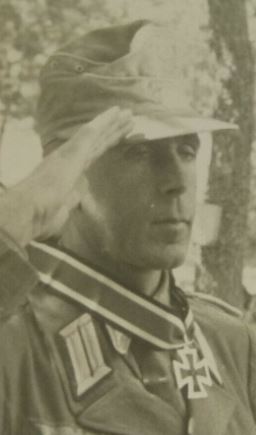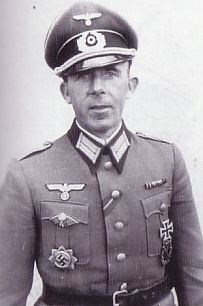Krüger, Walther (Panzergrenadier-Regiment 71)
- Date of birth:
- March 26th, 1902 (Kassel/Hesse-Nassau, Germany)
- Date of death:
- August 12th, 1958 (Kassel/Hesse, Germany)
- Nationality:
- German (1933-1945, Third Reich)
Biography
Promotions:
01.12.1925: Leutnant (96)
01.11.1928: Oberleutnant (39)
01.10.1934: Hauptmann (42)
01.06.1940: Major (26)
08.04.1942: Oberstleutnant - RDA 01.04.1942 (1009)
00.00.1943: Oberst - RDA 01.11.1943 (24a).
Career:
13.09.1920: Infanterieregiment 15
01.05.1926: 5. Kompanie, Infanterieregiment 15 (Weimar)
01.05.1933: 11. Kompanie, Infanterieregiment 15 (Kassel)
01.04.1934: 13. (MW) Kompanie, Infanterieregiment 15 (Kassel)
01.10.1934: Infanterieregiment 36
15.10.1935: Chef, 14. (PzAbw) Kompanie, Infanterieregiment 15 (Kassel)
12.10.1937: Chef, 4. (MG) Kompanie, Infanterieregiment 15 (Kassel)
10.11.1938: Chef, 4. (MG) Kompanie, Infanterieregiment 71 (Gotha)
01.04.1939: Chef, 7. Kompanie, Infanterielehrregiment (Döberitz)
28.09.1939: Kompaniechef, 11. Kompanie, Infanterieregiment "Großdeutschland"
05.06.1940: mit der Führung des I. Bataillon, Infanterieregiment "Großdeutschland"
11.07.1940: Kommandeur, III. Bataillon, Infanterieregiment "Großdeutschland"
13.12.1941: Ersatzbataillon "Großdeutschland"
16.03.1942: Kommandeur, II. Bataillon, Infanterieregiment "Großdeutschland"
23.04.1942: Stab des Generals der Infanterie, Oberkommando des Heeres
01.03.1942: Kommandeur, Panzergrenadier-Regiment 71
01.10.1944: Kommandeur, Infanterie-Lehr-Regiment Döberitz, Panzertruppenschule Bergen
01.02.1945: Abteilungschef und Leiter der Chefgruppe, Truppen-Abteilung, Allgemeines Heeresamt
Do you have more information about this person? Inform us!
- Period:
- Second World War (1939-1945)
- Rank:
- Hauptmann (Captain)
- Awarded on:
- 1939
- Period:
- Second World War (1939-1945)
- Rank:
- Hauptmann (Captain)
- Unit:
- Kompaniechef, 11. Kompanie, Infanterieregiment "Großdeutschland"
- Awarded on:
- May 19th, 1940
- Period:
- Second World War (1939-1945)
- Rank:
- Hauptmann (Captain)
- Unit:
- Kompaniechef, 11. Kompanie, Infanterieregiment "Großdeutschland"
- Awarded on:
- May 20th, 1940
- Period:
- Second World War (1939-1945)
- Rank:
- Major
- Unit:
- Kommandeur, III. Bataillon, Infanterie-Regiment (motorisiert) Großdeutschland, Heer
- Awarded on:
- October 20th, 1941
476th Award.
- Period:
- Second World War (1939-1945)
- Rank:
- Major
- Unit:
- Kdr, III. Bataillon, Infanterie-Regiment (motorisiert) Großdeutschland, Heer
- Awarded on:
- November 27th, 1941
- Period:
- Second World War (1939-1945)
- Rank:
- Major
- Unit:
- Kommandeur, III. Bataillon, Infanterieregiment "Großdeutschland"
- Awarded on:
- December 25th, 1941
- Period:
- Second World War (1939-1945)
- Rank:
- Oberstleutnant (Lieutenant-colonel)
- Unit:
- Kommandeur, II. Bataillon, Infanterieregiment "Großdeutschland"
- Awarded on:
- June 12th, 1942
- Period:
- Second World War (1939-1945)
- Rank:
- Oberstleutnant (Lieutenant-colonel)
- Unit:
- Kommandeur, II. Bataillon, Infanterieregiment "Großdeutschland"
- Awarded on:
- August 12th, 1942
- Period:
- Second World War (1939-1945)
- Rank:
- Oberstleutnant (Lieutenant-colonel)
- Unit:
- Kommandeur, Panzergrenadier-Regiment 71, 29. Panzergrenadier-Division, Heer
- Awarded on:
- August 27th, 1943
“On the 10.08.1943 the Regiment was in position northeast of the Zappulla river, with I. Bataillon on the right and II. Bataillon on the left.
I. Bataillon was especially depleted following the battles near Torrenuova—il Rilievo, a time in which it was broken through several times. It was in no condition to hold Hill 314 (the focal point of all enemy attacks) with the forces it had available. At around midday there were fears that the enemy would achieve a new breakthrough near K 108.
At around 12:00 the divisional commander provided an orientation at the regimental command post concerning the future intent of the Division. The Zappulla Position had to be held until the evening of the 12.08.1943, after which the Regiment was to occupy a new defensive line west of Funarie—Novara.
However the increasing enemy pressure (particularly along the coastal road) was a major concern, and it was feared that the I. Bataillon would be unable to hold its position until the ordered time. The Regiment thus requested that the I./71 be relieved by the III./71, which had previously been held back as the divisional reserve. This request was approved. The relief took place during the course of the afternoon (18:00).
Meanwhile the II./71 had finally taken Hill 314 following attacks by its 8. Kompanie, capturing prisoners and booty in the process. The enemy dug in on the opposite slope. Following strong artillery and mortar preparation, they tried to recapture the hill by attacking it in a double-pincer maneuver with assault parties. However all attacks during the night were repulsed.
At 20:00 on the 10.08.1943 the II./71 reported that 3 warships and 20 landing boats were sailing east. The Regiment believed that the enemy would try to land in the rear of the frontline, and at 21:30 it made a request to prematurely pull back the frontline to the area east of Capo d’Orlando. This request was turned down.
During the early morning hours of the 11.08.1943 the enemy landed west of Brolo with tanks and interdicted the coastal road.
At the same time the enemy commenced heavy attacks against Hill 314 and the positions of II. Bataillon, penetrating the line following the liberal use of smoke. The 20 men that were positioned at Malo evacuated the area at around 11:00. The enemy was now present in the deep left flank of III. Bataillon with about 2 companies.
Meanwhile the Regiment was receiving reinforcements in the shape of 6./Gr.Rgt. 15 as well as 2 Sturmgeschützen of the 4./Pz.Abt. 129. With these it was to recapture Hill 253 (which had been taken by the enemy forces that had landed in the rear) during the course of the morning.
At 11:50, following an intensification of the situation at the Zappulla river, the regimental commander ordered a withdrawal on his own initiative back to the Naso Position (which ran from K 95 on the coastal road along the eastern edge of the Naso valley up to 1 km west of S. Giuseppe). The Division was informed of this at the same time.
III./71 received orders to conduct a fighting withdrawal as it pulled back in the direction of K 105. II./71 was to pull back via Malo, Naso, S.Giuseppe and finally Ficarra. There it would establish a frontline facing westwards and try to establish contact with III./71, which was pulling back along the coastal road. In this way a new front west of Brolo would be built. These orders were issued to the Bataillonen via radio and confirmed by messengers.
After consulting with the divisional Ia the II./71 received new orders to not pull back to Ficarra. Instead it would swing northwards through the Naso valley and attack Hill 253 from the south.
After this conversation the regimental command post was relocated to the Capo d’Orlando—Brolo road in the vicinity of K 98. From this point forwards no radio contact existed with the Division.
At 13:30 the reconnaissance results confirmed that the Naso Position could only be occupied following the destruction of the landed enemy forces (in strength of about 3 companies) that were located there. Elements of 10. Kompanie were scattered from the left wing of the retreating III./71 and forced into the mountains.
At around 14:00 the commander of the 6./15 personally reported to the regimental commander on the coastal road and informed him of how he intended to employ his Kompanie. The impression he gave was that his Kompanie was descending through the Naso valley as ordered and would soon be ready to attack alongside the 2 Sturmgeschütze and the regimental Pionier-Zug. At this moment the withdrawing elements of the 12. and 11./71 also reported as ordered to the regimental command post. The commander of the 12./71 was personally ordered by the regimental commander to attack on the left side of the 6./15 along the coastal road. The ultimate objective was the Brolo railway station. 11./71 would follow along the coastal road behind 6./15.
The regrouping of the artillery and heavy weapons had been completed by 15:00. Those detachments that had been assigned to the Regiment were ordered to initially cover the withdrawal from the enemy. Then, at 18:00, elements of these would be diverted to support the attack along the coastal road. This fire would be intermittently directed by the regimental commander in close cooperation with the commanders of the II. and III. Abteilungen.
6 landing boats were reported to have gone out to sea near Brolo at 15:30. This was the sign to begin the attack. 1 heavy infantry gun, 2 Flak guns (2 cm) and 2 Sturmgeschützen supported the attack across the Naso bridge. The remnants of the 9. and 10. Kompanien meanwhile held off the strongly pursuing enemy forces that were emerging from the Zappulla valley. The attack was progressing smoothly in no small part thanks to the destruction of 5 Sherman tanks by the two Sturmgeschütze of the 4./Pz.Abt. 129, led by Leutnant Monze. The particularly flexibly directed artillery primarily guarded against flanking attempts from the south. The withdrawal of these elements back to Kap would only be authorized once the enemy began a renewed envelopment attempt along the Naso—Capa d’Orlando road.
The attack against Brolo was significantly delayed by the rough terrain west of the city as well as the well-built heavy weapons nests of the enemy forces atop of Hill 253. It also turned out that the 6./15 was only partially involved in the attack. Only 2 squads that had already been trucked to the area before the Naso bridge during the morning with the Kompanie commander (Oberleutnant Kolb) were attacking under the leadership of their commander. By dusk the lead elements were located just west of the city. The enemy that had pursued through Naso had reached the heights above the coastal road. The fire from the right flank was again revived, and this compelled the regimental commander to try to force the crossing over the Naso river with all forces at hand. At the same time he recognized that it was no longer possible to occupy the Naso Position. As the exact scale of the enemy landing was also unknown, the commander decided to breakthrough to Position II (which had been outlined by the divisional commander during the conference on the 10.08.1943). To this end it was ordered that all elements would drive along the road in a dense column. The trucks with the wounded were placed in the middle.
As the road was already under rifle and mortar fire, the guns of the II./A.R. 29 went into open firing positions and effectively engaged targets on the southern slopes of the road despite the gathering darkness.
The column set out for its breakthrough at 21:30, with a single self-propelled heavy infantry gun in the lead. All weapons were simultaneously fired at both the slopes and the terrain in which it was thought that the enemy could be occupying. Surprised by this, the enemy fire slackened somewhat. The column broke through and reached Brolo without losses in vehicles or guns. The number of wounded was minimal.
Contact with Gruppe Polack (which was fighting in Brolo) was established at 22:15 and reported to the Division via radio.
40 prisoners were taken. 5 Sherman tanks, as well as numerous MGs and mortars, were destroyed.
Following this linkup the Division ordered the occupation of the Gioiosa Marea—S. Lucia Position, and this was held until the evening of the 12.08.1943 as planned.”
Sources
- Photo 1:
- Photo 2:
- Photo: ,
- - FELLGIEBEL, W.P., Elite of theThird Reich, Helion & Company Limited, Solihull, 2003.
- PATZWALL, K. & SCHERZER, V., Das Deutsche Kreuz 1941-1945, Verlag Klaus D. Patzwall, Norderstedt, 2001.
- Stellenbesetzung Truppen-Abteilung Allgemeines Heeresamt.
- Götte, F. & Peiler, H., Die 29.Falke-Division – 1936-1945 29.I.D.-29.I.D. (mot)-29.Pz.Gren.Div., Nebel Verlag GmbH, Eggolsheim, Deutschland, 2003
- das-Ritterkreuz.de
- Scheibert, Horst. Die Träger des Deutschen Kreuzes in Gold (Das Heer). Podzun-Pallas Verlag, Friedberg, Germany, 1983, ISBN 3-7909-0207-1
- gmic.co.uk
















